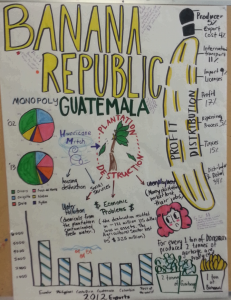Artifact #1 Infograph of a Banana Republic
I chose the infograph activity because I think it is a great example of a way for students to explore the interactions, interconnections and implications of a mono-economy in the world. They can see how the country they are studying interacts with the world economy, how it’s successes and failures are interconnected with the environment, and the local implications of a mono-economy (pollution, employment, etc).
It fits in with the new BC curriculum in that students use critical thinking during the research and note-taking phase while they are deciding which information is most important, communication and creative thinking while they create the infograph and decide collaboratively which information to put where, and personal/social competencies upon reflection of their work where they can see how their own grocery habits are connected to the country under study.
I would absolutely use this activity in a socials 8-11 class, social justice 12, geography 12, law 12, or home ec/family studies. One way I would adapt it is to use an infograph website instead of a hand written poster so that students can work on their computer literacy skills at the same time.
Infograph Websites Include: piecolor, statplanet, creately, wordle, tagxedo, infogram, visme, venngage, piktochart, improgrammer.

Artifact #2 “The True Cost” Documentary
I chose this documentary because it highlights the interactions, interconnections, and implications of the fashion industry. I think this is a topic that students can relate to as all of them wear clothes and many of them probably shop at the stores that are mentioned in the film.
There are so many jumping off points in this film for exploring: the interactions between the multinational countries of the west and manufacturing companies of developing countries; the interconnections between “our” (North American) buying habits and the struggles of garment workers to make a liveable wage; the implications of the current fashion industry for the environment, human rights, and sustainability.
This documentary could be used in any course that has a social justice element. It is a great hook for the topics mentioned above. There are an infinite activities that could stem from this film. For example, students could watch the first 20 minutes of the film and take some notes on “fast fashion” or “sweat shops” (with a guided note taking worksheet) then do some additional research in a webquest and finally combine the collected research into an infograph.
